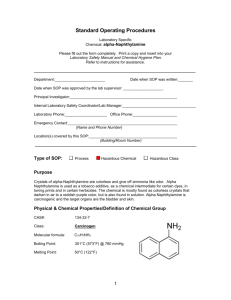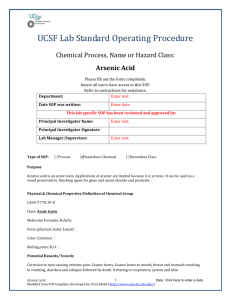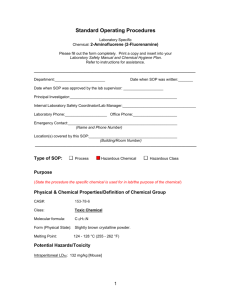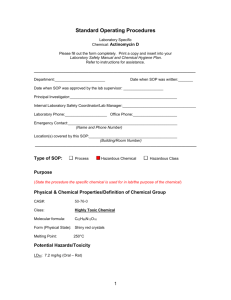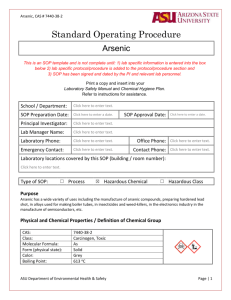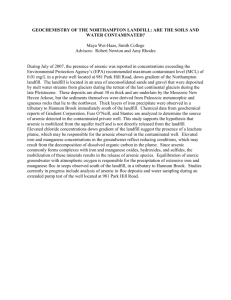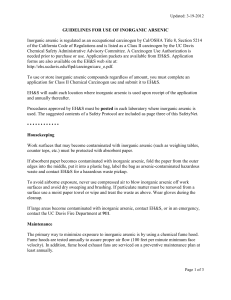UCLA - Environmental Health & Safety
advertisement
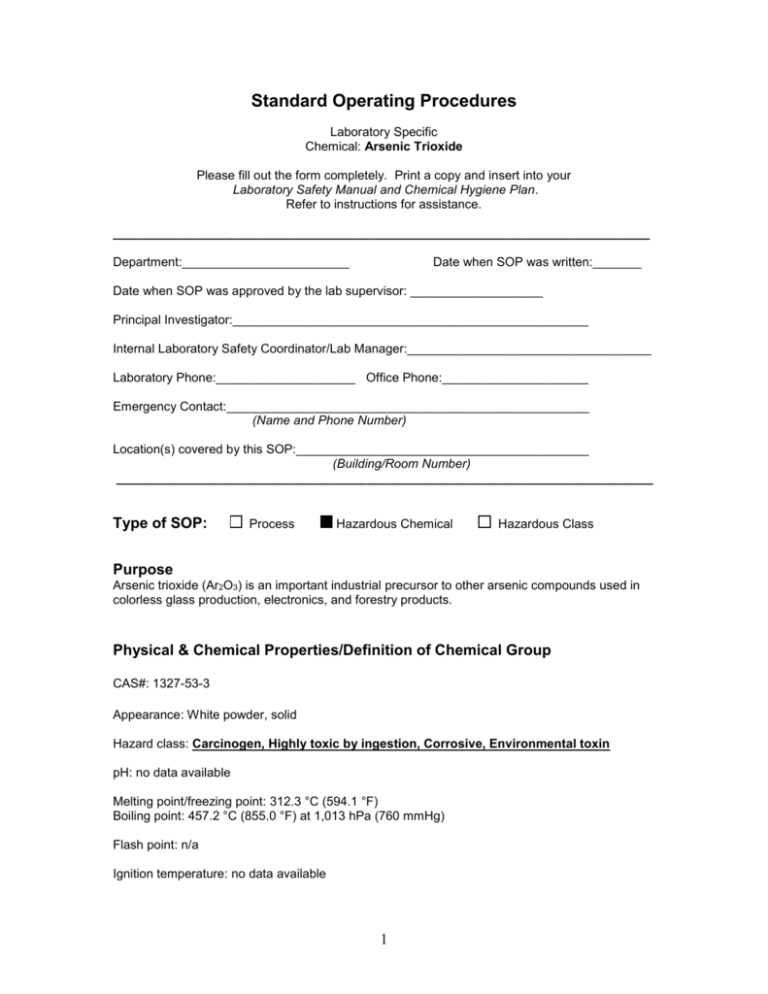
Standard Operating Procedures Laboratory Specific Chemical: Arsenic Trioxide Please fill out the form completely. Print a copy and insert into your Laboratory Safety Manual and Chemical Hygiene Plan. Refer to instructions for assistance. _____________________________________________________________________________ Department:________________________ Date when SOP was written:_______ Date when SOP was approved by the lab supervisor: ___________________ Principal Investigator:___________________________________________________ Internal Laboratory Safety Coordinator/Lab Manager:___________________________________ Laboratory Phone:____________________ Office Phone:_____________________ Emergency Contact:____________________________________________________ (Name and Phone Number) Location(s) covered by this SOP:__________________________________________ (Building/Room Number) _____________________________________________________________________________ Type of SOP: Process Hazardous Chemical Hazardous Class Purpose Arsenic trioxide (Ar2O3) is an important industrial precursor to other arsenic compounds used in colorless glass production, electronics, and forestry products. Physical & Chemical Properties/Definition of Chemical Group CAS#: 1327-53-3 Appearance: White powder, solid Hazard class: Carcinogen, Highly toxic by ingestion, Corrosive, Environmental toxin pH: no data available Melting point/freezing point: 312.3 °C (594.1 °F) Boiling point: 457.2 °C (855.0 °F) at 1,013 hPa (760 mmHg) Flash point: n/a Ignition temperature: no data available 1 Autoignition temperature: no data available Lower explosion limit: no data available Upper explosion limit: no data available Vapor pressure: 0.000001 hPa (0.000001 mmHg) at 66 °C (151 °F) Density: 3.738 g/cm3 Water solubility: soluble Partition coefficient: no data available log Pow: no data available Potential Hazards/Toxicity Routes of exposure Ingestion: Severely toxic effects may result from the accidental ingestion of the material; animal experiments indicate that ingestion of less than 5 gram may be fatal or may produce serious damage to the health of the individual. The material can produce chemical burns within the oral cavity and gastrointestinal tract following ingestion. Ingestion may produce nausea, vomiting and diarrhea, bloody stools, shock, rapid pulse and coma. Severe gastritis or gastroenteritis may occur as a result of lesions produced by vascular damage from absorbed arsenic (and not local corrosion); symptoms may be delayed for several hours. Eye exposure: The material can produce chemical burns to the eye following direct contact. Vapors or mists may be extremely irritating.If applied to the eyes, this material causes severe eye damage. Skin contact: The material can produce chemical burns following direct contact with the skin. Skin contact with the material may damage the health of the individual; systemic effects may result following absorption. Arsenic can cause skin irritation characterized by eczema, scaling, sensitization, and discoloration and thickening of the palms and soles. Open cuts, abraded or irritated skin should not be exposed to this material. Entry into the blood-stream, through, for example, cuts, abrasions or lesions, may produce systemic injury with harmful effects. Examine the skin prior to the use of the material and ensure that any external damage is suitably protected. Inhalation: If inhaled, this material can irritate the throat and lungs of some persons. Inhalation of dusts, generated by the material, during the course of normal handling, may produce toxic effects. Persons with impaired respiratory function, airway diseases and conditions such as emphysema or chronic bronchitis, may incur further disability if excessive concentrations of particulate are inhaled. Inhaling materials containing arsenic can cause severe irritation to the nose, throat and lungs. Prolonged exposure can cause severe structural damage to the nose. Chronic health effects: Repeated or prolonged exposure to corrosives may result in the erosion of teeth, inflammatory and ulcerative changes in the mouth and necrosis (rarely) of the jaw. Bronchial irritation, with cough, and frequent attacks of bronchial pneumonia may ensue. Limited evidence suggests that repeated or long-term occupational exposure may produce cumulative health effects involving organs or biochemical systems. There is limited evidence that, skin contact with this product is more likely to cause a sensitization 2 reaction in some persons compared to the general population. Long term exposure to high dust concentrations may cause changes in lung function i.e. pneumoconiosis; caused by particles less than 0.5 micron penetrating and remaining in the lung. Longterm exposure to arsenic and its inorganic salts may produce loss of appetite, nausea and vomiting, low fever, persistent headache, pallor, weakness and phlegm. Skin effects include redness, eczema, pigmentation, diffuse hair loss, scaling of the palms and soles, sloughing, brittle nails, white lines or bands on the nails, loss of hair and nails, and localized swelling. There is sufficient evidence to suggest that this material directly causes cancer in humans. Personal Protective Equipment (PPE) Respiratory protection: Where risk assessment shows air-purifying respirators are appropriate use a full-face particle respirator type N100 (US) or type P3 (EN 143) respirator cartridges as a backup to engineering controls. If the respirator is the sole means of protection, use a full-face supplied air respirator. Use respirators and components tested and approved under appropriate government standards such as NIOSH (US) or CEN (EU). Hand protection: Handle with gloves. Gloves must be inspected prior to use. Use proper glove removal technique (without touching glove's outer surface) to avoid skin contact with this product. Dispose of contaminated gloves after use in accordance with applicable laws and good laboratory practices. Wash and dry hands. Eye protection: Face shield and safety glasses. Use equipment for eye protection tested and approved under appropriate government standards such as NIOSH (US) or EN 166(EU). Skin and body protection: In addition to full length pants and closed toed shoes, a lab coat should also be worn. The type of protective equipment must be selected according to the concentration and amount of the chemical used. Hygiene measures: Avoid contact with skin, eyes and clothing. Wash hands before breaks and immediately after handling the product. Engineering Controls Employees working with confirmed human carcinogens should be authorized to do so by the employer, and work in a regulated area such as a fume hood. Within regulated areas, the carcinogen should be stored in sealed containers, or enclosed in a closed system, including piping systems, with any sample ports or openings closed while the carcinogens are contained within. Open-vessel systems are prohibited. Each operation should be provided with continuous local exhaust ventilation so that air movement is always from ordinary work areas to the operation. Exhaust air should not be discharged to regulated areas, non-regulated areas or the external environment unless decontaminated. Clean make-up air should be introduced in sufficient volume to maintain correct operation of the local exhaust system. Except for outdoor systems, regulated areas should be maintained under negative pressure (with respect to non-regulated areas). Local exhaust ventilation requires make-up air be supplied in equal volumes to replaced air. 3 First Aid Procedures General advice: Consult a physician. Show this safety data sheet to the doctor in attendance. Move out of dangerous area. If ingested: Give a slurry of activated charcoal in water to drink. NEVER GIVE AN UNCONSCIOUS PATIENT WATER TO DRINK. At least 3 tablespoons in a glass of water should be given. In case of eye contact: Immediately hold eyelids apart and flush the eye continuously with running water for at least 15 minutes. Ensure complete irrigation of the eye by keeping eyelids apart and away from eye and moving the eyelids by occasionally lifting the upper and lower lids. In case of skin contact: Immediately flush body and clothes with large amounts of water, using safety shower if available for a minimum of 15 minutes. Quickly remove all contaminated clothing, including footwear. If inhaled: If fumes or combustion products are inhaled remove from contaminated area. Lay patient down. Keep warm and rested. Notes to physician Treat as per arsenic poisoning. Acute skin lesions such as contact dermatitis usually do not require other treatment than removal from exposure. If more severe symptoms of the respiratory system, the skin or the gastro-intestinal tract occur, British Anti-Lewisite (BAL, dimercaprol) may be given. Prompt administration in such cases is vital; to obtain maximum benefit such treatment should be administered within 4 hours of poisoning. Pre-placement and periodic medical examinations are essential for workers exposed to arsenic on a regular basis. Pre-placement physical examinations should give particular attention to allergic and chronic skin lesions, eye disease, psoriasis, chronic eczematous dermatitis, hyperpigmentation of the skin, keratosis and warts, baseline weight, baseline blood and hemoglobin counts, baseline urinary arsenic determinations. Annual physical examinations should give attention to general health, weight, skin condition, and any evidence of excessive exposure or absorption of arsenic. Pre-employment medical examinations should be carried out. It is not recommended to employ persons with pre-existing diabetes, cardiovascular diseases, allergic or other skin diseases, neurologic, hepatic or renal lesions in arsenic work. Periodic medical examinations of all arsenic-exposed employees (male or female) should be performed with special attention to possible arsenic related symptoms. [ILO Encyclopaedia] Special Handling and Storage Requirements Precautions for safe handling: Avoid all personal contact, including inhalation. Wear protective clothing when risk of exposure occurs. Conditions for safe storage: Segregate from acids, alkalis, oxidizing agents, halogens and halogen compounds including chlorine trifluoride, fluorine, hydrogen fluoride, oxygen difluoride and sodium chlorate. Contact with nascent hydrogen may produce arsine gas (arsenic hydride). Reacts violently on contact with chlorine trifluoride, fluorine, hydrogen 4 fluoride, oxygen difluoride, sodium chlorate and other strong oxidizers. May produce arsine gas (extremely poisonous) by contact with acids, alkalis or water in the presence of an active metal (zinc, aluminium, magnesium, manganese, sodium, iron, etc.). Spill and Accident Procedure Chemical Spill Dial 911 and x59797 Spill – Help contaminated or injured persons. Evacuate the spill area. Avoid breathing dusts and use a respirator if possible. If possible, confine the spill to a small area using a spill kit or absorbent material. Keep others from entering contaminated area (e.g., use caution tape, barriers, etc.). Small (<1 L) – If you have training, you may assist in the clean-up effort. Use appropriate personal protective equipment and clean-up material for chemical spilled. Double bag spill waste in clear plastic bags, label and take to the next chemical waste pick-up. Large (>1 L) – Dial 911 (or 310-825-1491 from cell phone) and EH&S at x59797 for assistance. Chemical Spill on Body or Clothes – Remove clothing and rinse body thoroughly in emergency shower for at least 15 minutes. Seek medical attention. Notify supervisor and EH&S at x59797 immediately. Chemical Splash Into Eyes – Immediately rinse eyeball and inner surface of eyelid with water for 15 minutes by forcibly holding the eye open. Seek medical attention. Notify supervisor and EH&S at x59797 immediately. Medical Emergency Dial 911 or x52111 Life Threatening Emergency, After Hours, Weekends And Holidays – Dial 911 (or 310-825-1491 from cell phone) or contact the Ronald Reagan UCLA Medical Center (emergency room) directly at x52111 (located at 757 Westwood Plaza, enter from Gayley Avenue). Note: All serious injuries must be reported to EH&S at x59797 within 8 hours. Non-Life Threatening Emergency– Go to the Occupational Health Facility (OHF), x56771, CHS room 67-120 (This is on the 6th floor, 7th corridor, room 120. Enter through the School of Dentistry on Tiverton Drive and proceed to the “O” elevator to the 6th floor.)Hours: M F, 7:30 a.m. to 4:30 p.m. At all other times report to Ronald Regan UCLA Medical Center (emergency room) at x52111. Note: All serious injuries must be reported to EH&S at x59797 within 8 hours. Needle stick/puncture exposure (as applicable to chemical handling procedure)– Wash the affected area with antiseptic soap and warm water for 15 minutes. For mucous membrane exposure, flush the affected area for 15 minutes using an eyewash station. Page the needle stick nurse by dialing 231 from a campus phone, enter 93333 when prompted and then enter your extension. Hours: M – F, 8:00 a.m. to 4:00 p.m. At all other times report to Ronald Regan UCLA Medical Center (emergency room) at x52111. Note: All needle stick/puncture exposures must be reported to EH&S at x59797 within 8 hours. 5 Decontamination/Waste Disposal Procedure Hazardous waste disposal guidelines: Contact hazardousmaterials@ehs.ucla.edu or x61887 / x45569 regarding disposal procedure for empty containers. Material Safety Data Sheet (MSDS) Location (State the location of MSDS) Hardcopy or electronic copy must be available. Online MSDS can be accessed at http://msds.ehs.ucla.edu. Protocol/Procedure (Add specific description of procedure) Any deviation from this SOP requires approval from PI. Documentation of Training (signature of all users is required) I have read and understand the content of this SOP: Name Signature 6 Date


